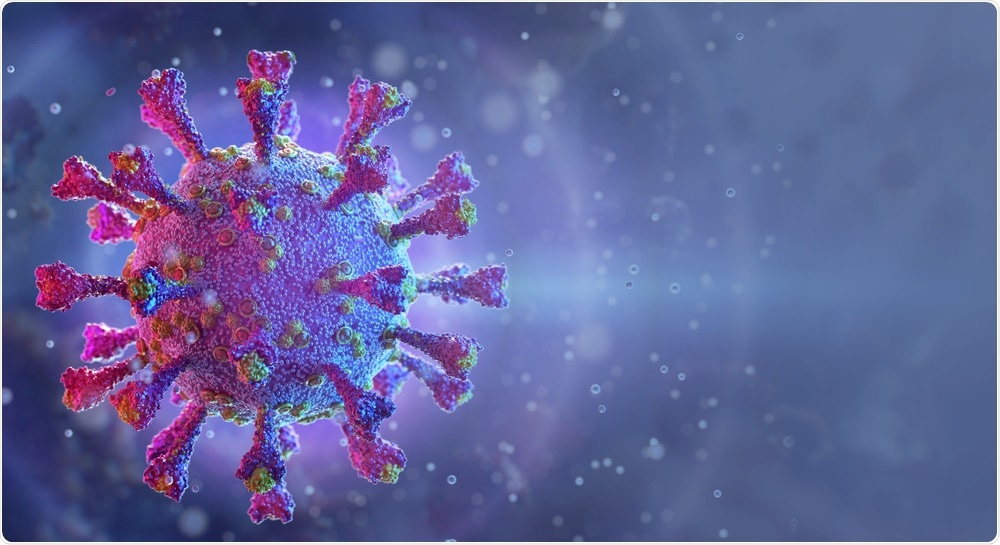A recent study published in JAMA Network Open discusses the potential utility of daily symptom tracking tools to estimate the number of coronavirus disease 2019 (COVID-19) hospitalizations that will occur within one week of reporting COVID-19-related symptoms.

SARS-CoV-2. Image Credit: Corona Borealis Studio/Shutterstock.com
The utility of symptom monitoring
Early in the COVID-19 pandemic, businesses and hospitals alike required their employees to report any symptoms they may have been experiencing that could have been related to undiagnosed COVID-19. Such symptom monitoring tools allowed employers to direct potentially symptomatic employees to obtain follow-up testing. Despite the utility that these symptom monitoring tools had when there was a limited availability of COVID-19 tests, one weakness of this approach was that it failed to identify infectious and asymptomatic employees.
Recent studies suggest that as members of a community, hospital employees who routinely report their symptoms could serve as a surrogate of symptom reporting for their community. To test this hypothesis, a cohort study was conducted from April 2, 2020, to November 4, 2020, at a large academic hospital network of 10 hospitals in Boston, Massachusetts.
Can symptom monitoring be used as syndromic surveillance?
In their study, the researchers aimed to identify whether daily employee symptom tracking tools could be used as syndromic surveillance to estimate the number of COVID-19 hospitalizations within those same communities. Taken together, this large hospital system had 2,384 staffed beds and an annual inpatient discharge rate of 136,000. In total, 6,841 employees were living within the 10 hospitals’ service areas during the time of this study.
As compared to other national epidemiological studies that estimate COVID-19 deaths about 10 weeks into the future, the researchers of the current study instead sought to only estimate into the immediate future of one week, and estimate hospitalization rates rather than COVID-19 deaths.
The data collection tool that was used in the current study was an automated text messaging system, wherein employees would receive a text message each morning asking them to complete their daily symptom monitoring assessment. The first question asked, ‘Will you be working onsite at a [hospital] facility today?’.
Employees who responded yes to this question would then be asked to identify whether they were experiencing any of the following symptoms:
- Fever of greater than 100.4°F or feverish
- Cough
- Sore throat
- Shortness of breath
- Unusual fatigue
- Chills
- Body aches
- Vomiting
- Diarrhea
- Nausea
- Abdominal pain
- Loss of smell or taste
If an employee reported that they were experiencing any of the aforementioned COVID-related symptoms, they were subsequently asked to report the specific symptom they were experiencing from the list.
Study outcomes
The primary outcomes of the current study included the mean absolute error (MAE) and weighted mean absolute percentage of error (MAPE) of the daily COVID-19 hospital census numbers across all the complete hospital networks. The secondary outcomes included the MAE and weighted MAPE within each of the 10 hospital service areas in this hospital network.
The zip codes of the employees who reported experiencing any COVID-related symptom were matched to the service areas of the hospitals within the network. In turn, the employees were matched to the hospital closest to where they live, rather than the hospital at which they work.
Taken together, the researchers found that in larger hospitals that had a greater number of employees residing in their service areas, employee symptoms were associated with an increase in COVID-19-related hospitalization rates. For example, when twice as many employees reported symptoms in hospital 1, which is a tertiary, academic, teaching hospital in Boston, the researchers found that there was a 5% increase in COVID-19 hospitalizations to arise in that hospital in 7 days.
While there are notable limitations associated with the current study, the data discussed here suggests that utilizing symptom monitoring tools could assist in making operational decisions in surge planning during a pandemic, particularly when more accurate testing is not readily available.
Journal reference:
- Horng, S., O’Donoghue, A., Dechen, T., et al. (2021). Secondary Use of COVID-19 Symptom Incidence Among Hospital Employees as an Example of Syndromic Surveillance of Hospital Admissions Within 7 Days. JAMA Network Open 4(6); e2113782. doi:10.1001/jamanetworkopen.2021.13782.